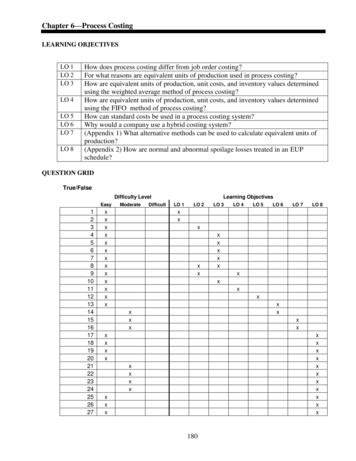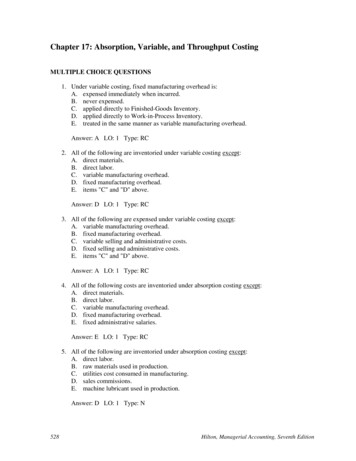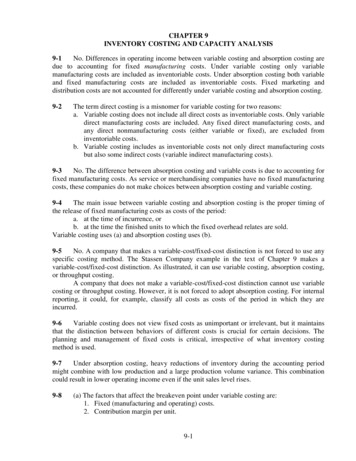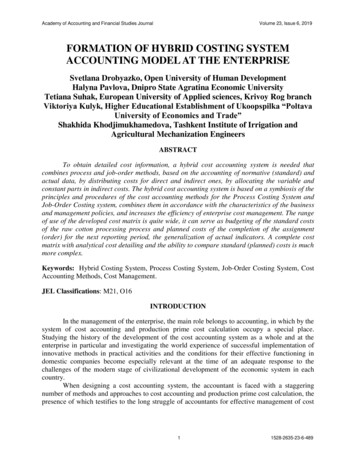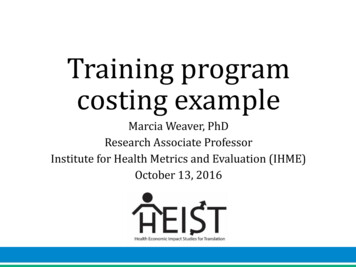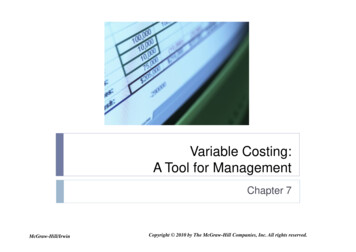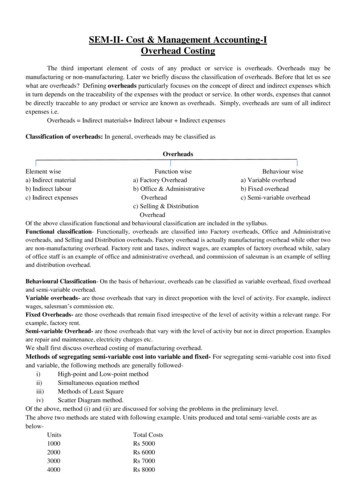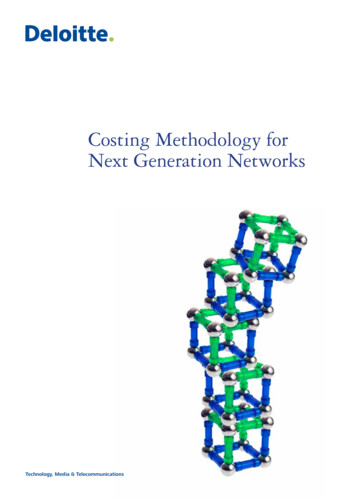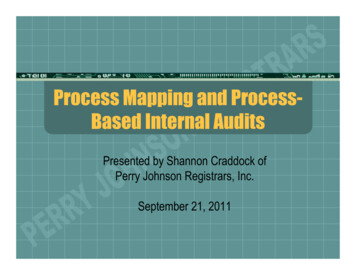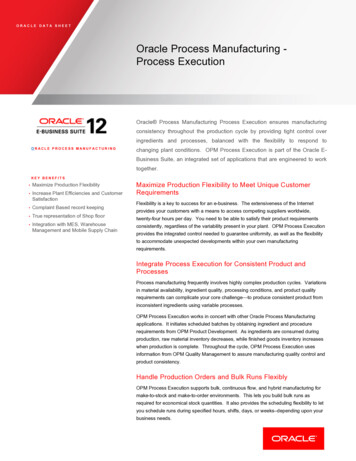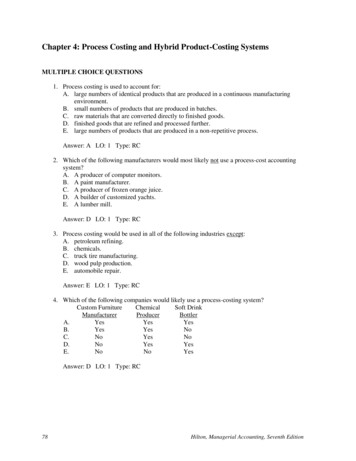
Transcription
Chapter 4: Process Costing and Hybrid Product-Costing SystemsMULTIPLE CHOICE QUESTIONS1. Process costing is used to account for:A. large numbers of identical products that are produced in a continuous manufacturingenvironment.B. small numbers of products that are produced in batches.C. raw materials that are converted directly to finished goods.D. finished goods that are refined and processed further.E. large numbers of products that are produced in a non-repetitive process.Answer: A LO: 1 Type: RC2. Which of the following manufacturers would most likely not use a process-cost accountingsystem?A. A producer of computer monitors.B. A paint manufacturer.C. A producer of frozen orange juice.D. A builder of customized yachts.E. A lumber mill.Answer: D LO: 1 Type: RC3. Process costing would be used in all of the following industries except:A. petroleum refining.B. chemicals.C. truck tire manufacturing.D. wood pulp production.E. automobile repair.Answer: E LO: 1 Type: RC4. Which of the following companies would likely use a process-costing system?Custom FurnitureChemicalSoft sNoC.NoYesNoD.NoYesYesE.NoNoYesAnswer: D LO: 1 Type: RC78Hilton, Managerial Accounting, Seventh Edition
5. Which of the following statements regarding similarities between process costing and job-ordercosting are true?I.Both systems assign production costs to units of output.II. Both systems require extensive knowledge of financial accounting.III. The flow of costs through the manufacturing accounts is essentially the same.A.B.C.D.E.I only.I and III.II and III.III only.I, II, and III.Answer: B LO: 1 Type: RC6. Companies that use a process-cost accounting system would:A. establish a separate Work-in-Process Inventory account for each manufacturing department.B. establish a separate Finished-Goods Inventory account for each manufacturing department.C. pass completed production directly to Cost of Goods Sold.D. charge goods produced with actual overhead amounts rather than applied overhead amounts.E. eliminate the need for the Finished-Goods Inventory account.Answer: A LO: 1 Type: RC7. Which of the following statements is false?A. In job-order costing, costs are accumulated by job order.B. In process costing, costs are accumulated by department.C. In process costing, the cost per unit in a department is found by spreading the period'smanufacturing costs over the production activity.D. In process costing, the total cost of each unit is found by dividing the total factory costs bythe number of units completed.E. In job-order costing, the unit cost is found by dividing the job's total cost by the job's totalunits.Answer: D LO: 1 Type: RC8. In a process-costing system, manufacturing costs are accumulated by:A. batch.B. batch and time period.C. department.D. department and time period.E. department or process, and time period.Answer: E LO: 1 Type: NChapter 479
9. Which of the following choices correctly shows how costs are accumulated in a process-costingsystem?ByBy TimeBy Process sNoD.NoYesYesE.NoNoYesAnswer: D LO: 1 Type: N10. Morrison, Inc., which uses a process-cost accounting system, passes completed production fromDepartment A to Department B for further manufacturing. The journal entry to record completedproduction in Department A requires:A. a debit to Work-in-Process Inventory and a credit to Finished-Goods Inventory.B. a debit to Finished-Goods Inventory and a credit to Work-in-Process Inventory.C. a debit to Finished-Goods Inventory and a credit to Work-in-Process Inventory: DepartmentA.D. a debit to Work-in-Process Inventory: Department A and a credit to Work-in-ProcessInventory: Department B.E. a debit to Work-in-Process Inventory: Department B and a credit to Work-in-ProcessInventory: Department A.Answer: E LO: 2 Type: A11. Greene, Inc., which uses a process-costing system, transfers completed production fromDepartment no. 1 to Department no. 2 for further work. Which of the following best describesthe account that would be debited to record this transfer?A. Cost of Goods Transferred.B. Finished-Goods Inventory: Department no. 1.C. Finished-Goods Inventory: Department no. 2.D. Work-in-Process Inventory: Department no. 1.E. Work-in-Process Inventory: Department no. 2.Answer: E LO: 2 Type: A12. Barnes, Inc., which uses a process-costing system, transfers completed production fromDepartment no. 1 to Department no. 2 for further work. Which of the following best describesthe account that would be credited to record this transfer?A. Cost of Goods Transferred.B. Finished-Goods Inventory: Department no. 1.C. Finished-Goods Inventory: Department no. 2.D. Work-in-Process Inventory: Department no. 1.E. Work-in-Process Inventory: Department no. 2.Answer: D LO: 2 Type: A80Hilton, Managerial Accounting, Seventh Edition
13. Hamilton, which uses a process-costing system, had a balance in its Work-in-Process account of 68,000 on January 1. The account was charged with direct materials, direct labor, andmanufacturing overhead of 450,000 throughout the year. If a review of the accounting recordsdetermined that 86,000 of goods were still in production at year-end, Hamilton should make ajournal entry on December 31 that includes:A. a debit to Cost of Goods Sold for 432,000.B. a credit to Finished-Goods Inventory for 432,000.C. a credit to Work-in-Process Inventory for 432,000.D. a debit to Finished-Goods Inventory for 86,000.E. a credit to Work-in-Process Inventory for 86,000.Answer: C LO: 2 Type: A14. Unit costs in a process-costing system are derived by using:A. in-process units.B. completed units.C. physical units.D. equivalent units.E. a measure of activity other than those listed above.Answer: D LO: 3 Type: RC15. Barnett Corporation had 6,500 units of work in process on April 1. During April, 19,100 unitswere completed and as of April 30, 5,100 units remained in production. How many units werestarted during April?A. 11,600.B. 17,700.C. 20,500.D. 30,700.E. None of the above.Answer: B LO: 3 Type: A16. XYZ Co., had 3,000 units of work in process on April 1 that were 60% complete. During April,10,000 units were completed and as of April 30, 4,000 units that were 40% complete remained inproduction. How many units were started during April?A. 8,600.B. 9,800.C. 11,000.D. 12,200.E. None of the above.Answer: C LO: 3 Type: AChapter 481
17. Ohio, Inc., which uses a process-cost accounting system, began operations on January 1 of thecurrent year. The company incurs conversion cost evenly throughout manufacturing. If Ohiostarted work on 3,000 units during the period and these units were 70% of the way throughmanufacturing, it would be correct to say that the company has:A. 3,000 physical units in production.B. 2,100 completed units.C. 900 in-process units.D. 900 equivalent units of production.E. 3,000 equivalent units of production.Answer: A LO: 3 Type: A18. Which of the following data are needed to calculate total equivalent units under the weightedaverage method?A. Work-to-date on ending work in process, units started during the period.B. Units completed during the period, work-to-date on ending work in process.C. Work to complete beginning work in process, work-to-date on ending work in process.D. Work to complete beginning work in process, units completed, work done on ending work inprocess.E. Units completed, work to complete beginning work in process.Answer: B LO: 3 Type: RC19. Kentucky Corporation uses a process-cost accounting system. The company adds direct materialsat the start of its production process; conversion cost, on the other hand, is incurred evenlythroughout manufacturing. The firm has no beginning work-in-process inventory; its endingwork in process is 40% complete. Which of the following sets of percentages would be used tocalculate the correct number of equivalent units in the ending work-in-process inventory?A. Materials, 40%; conversion cost, 40%.B. Materials, 40%; conversion cost, 100%.C. Materials, 100%; conversion cost, 40%.D. Materials, 100%; conversion cost, 60%.E. Materials, 100%; conversion cost, 100%.Answer: C LO: 3 Type: A20. Agora Company uses a process-cost system for its single product. Material A is added at thebeginning of the process; in contrast, material B is added when the units are 75% complete. Thefirm's ending work-in-process inventory consists of 6,000 units that are 80% complete. Which ofthe following correctly expresses the equivalent units of production with respect to materials Aand B in the ending work-in-process inventory?A. A, 4,800; B, 0.B. A, 4,800; B, 4,800.C. A, 6,000; B, 0.D. A, 6,000; B, 4,800.E. A, 6,000; B, 6,000.Answer: E LO: 3 Type: A, N82Hilton, Managerial Accounting, Seventh Edition
21. Willingham uses a process-costing system for its single product, which is manufactured fromMaterial X and Material Y. X and Y are introduced to the product as follows:Material X: Added at the beginning of manufacturingMaterial Y: Added at the 75% stage of completionThe company started and completed 40,000 units during the period, and had an ending work-inprocess inventory amounting to 8,000 units, 20% complete. Which of the following choicescorrectly expresses the total equivalent units of production with respect to Material X andMaterial Y?Material XMaterial 041,600E.48,00046,000Answer: C LO: 3 Type: A, NUse the following to answer questions 22-23:Hampton Textile Co., manufactures a variety of fabrics. All materials are introduced at the beginning ofproduction; conversion cost is incurred evenly through manufacturing. The Weaving Department had2,000 units of work in process on April 1 that were 30% complete as to conversion costs. During April,9,000 units were completed and on April 30, 4,000 units remained in production, 40% complete withrespect to conversion costs.22. The equivalent units of direct materials for April total:A. 9,000.B. 13,000.C. 13,600.D. 14,400.E. 15,000.Answer: B LO: 3 Type: A23. The equivalent units of conversion for April total:A. 9,000.B. 10,600.C. 11,200.D. 12,000.E. 12,600.Answer: B LO: 3 Type: AChapter 483
24. Columbia Corporation adds all materials at the beginning of production and incurs conversioncost evenly throughout manufacturing. The company completed 50,000 units during the year andhad 15,000 units in process at December 31, 30% complete with respect to conversion cost.Equivalent units for the year total:A. materials, 50,000; conversion, 50,000.B. materials, 50,000; conversion, 4,500.C. materials, 54,500; conversion, 54,500.D. materials, 65,000; conversion, 54,500.E. materials, 65,000; conversion, 65,000.Answer: D LO: 3 Type: A25. Gregory, which uses a process-costing system, adds all material at the beginning of productionand incurs conversion cost evenly throughout manufacturing. The information that followsrelates to the period just ended:Units started and completed: 75,000Units in ending work-in-process inventory: 15,000, 60% completeWhich of the following choices correctly expresses the total equivalent units of production withrespect to material and conversion cost?MaterialConversionA. 75,00075,000B.84,00084,000C.90,00081,000D. 90,00084,000E.90,00090,000Answer: D LO: 3 Type: A26. Gorski began operations on January 1 of the current year. The company uses a process-costingsystem, and conversion cost is incurred evenly throughout manufacturing. By January 31, thefirm had completed 56,000 units. Which of the following statements could be true about theending work-in-process inventory if equivalent units for conversion cost totaled 59,000 units?A. There is no ending work-in-process inventory.B. The ending work-in-process inventory totaled 3,000 physical units.C. The ending work-in-process inventory of 10,000 physical units was 30% complete.D. The ending work-in-process inventory of 20,000 physical units was 85% complete.E. More than one of the above could be true.Answer: C LO: 3 Type: A, N84Hilton, Managerial Accounting, Seventh Edition
27. Majestic, which uses a process-costing system, adds material at the beginning of production andincurs conversion cost evenly throughout manufacturing. The following selected information wastaken from the company's accounting records:Total equivalent units of materials: 5,000Total equivalent units of conversion: 4,400Units started and completed during the period: 3,500On the basis of this information, the ending work-in-process inventory's stage of completion is:A. 40%.B. 60%.C. 70%.D. 80%.E. some other percentage not listed above.Answer: B LO: 3 Type: A, N28. Corruption, Inc., overstated the percentage of work completed with respect to conversion cost onthe ending work-in-process inventory. What is the effect of this overstatement on conversioncost equivalent units and physical units manufactured, respectively?A. Overstated, overstated.B. Overstated, understated.C. Overstated, none.D. None, overstated.E. None, none.Answer: C LO: 3 Type: N29. Michael, Inc., uses a process-costing system. A newly hired accountant has identified thefollowing procedures that must be performed by the close of business on Friday:1—Calculation of equivalent units2—Analysis of physical flows of units3—Assignment of costs to completed units and units still in process4—Calculation of unit costsWhich of the following choices correctly expresses the proper order of the preceding tasks?A. 1, 2, 3, 4.B. 1, 2, 4, 3.C. 1, 4, 3, 2.D. 2, 1, 4, 3.E. 2, 1, 3, 4.Answer: D LO: 3 Type: RCChapter 485
30. When calculating unit costs under the weighted-average process-costing method, the unit cost isbased on:A. only the current period's manufacturing costs.B. only costs in the period's beginning work-in-process inventory.C. a summation of the costs in the beginning work-in-process inventory plus costs incurred inthe current period.D. only costs incurred in previous accounting periods.E. a summation of the costs in t
Chapter 4: Process Costing and Hybrid Product-Costing Systems 78 Hilton, Managerial Accounting, Seventh Edition MULTIPLE CHOICE QUESTIONS 1. Process costing is used to account for: A. large numbers of identical products that are produced in a continuous manufacturing environment. B. small numbers of products that are produced in batches.
